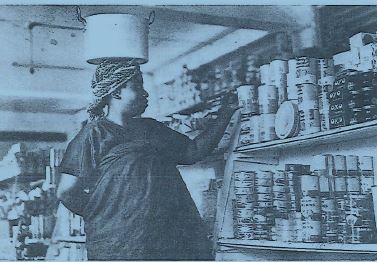Published by The Politics of Health Group 1979. The references have been omitted.
While the government tells us to look after our own health and to eat wisely, the manufacturers are busy promoting increasingly harmful food. Both in the production of food and in its consumption the main criteria are not those of health but those of profit
In this pamphlet we have taken the food industry as an example of the way in which ill-health is produced in our society.
The Politics of Health Group exists to develop a better understanding of how health and disease are produced in our society. We believe that the fundamental causes of ill-health lie in the social and economic structure of society. Therefore they are matters for public debate and political action.
PAMPHLET NUMBER ONE
This pamphlet is about health and illness. When we are ill we think what can be done about it — and we turn to doctors and nurses, drugs and surgery. We rarely ask why we fell ill in the first place. Yet the chances of becoming ill, and even the length of our lives, depend less on the health services available than on, for example, income, working conditions, housing … and the food we eat.
The government tells us to get more exercise and eat better food. The Royal College of Physicians tell us we are killing ourselves with over-eating, smoking or not following their instructions. This is blaming the victim.
We wrote this discussion pamphlet because we believe that ‘blaming the victim’ distorts the real situation. We believe that the causes of ill health are to be found deeply embedded in the fabric of the society in which we live.
To show how health is affected by social and economic conditions, we have taken an example we are familiar with: we chose food, its production and consumption — but the same basic points could have been illustrated equally well using housing or transportation as examples.
A lot has been written about the problems of our diet and the food we consume. Although ownership of land and production of food have long been serious political issues, questions about the nature of the food — our diet and the decisions about what we eat — are rarely analysed in a political context. Either we haven’t thought about food at all, or we have vague ideas about preservatives, cholesterol, brown rice or sugar.
In this pamphlet we look at the development of the food industry, the nature of the diet generally consumed, the nature of food production and the ill-health of the work force. We try to show how ill-health is the consequence both of what is produced and how it is produced, and that these are closely linked to one another.
We hope that this document will be widely distributed and discussed in the women’s and trades union movements, and theparties and organisations that work in these movements. In particular we want to draw in food producers and health workers to discuss the question of what is produced, under what conditions, and for what reasons. We believe GOOD FOOD SHOULD BE PRODUCED UNDER HEALTHY WORKING CONDITIONS, rather than, as now, subordinated to the need for profit.
FOOD AND ILLNESS
If you were to believe the food industry, you might well believe that ill-health resulting from poor diet was entirely a thing of the past. But it is very much a thing of the present.
Do you know which diseases you are most likely to suffer from? Unlike people in past generations, you are unlikely to suffer or die from serious infections. But there are other forms of illness which are increasingly affecting all of us in Britain.
The economic and social organisation of society has changed, and with it the pattern of disease. The changes in our diet and in the way food is produced are important causes of the changes in ill-health — as we shall show in later sections. In this first section we want to show some examples of current health problems, and how the type of food we eat is a major cause of their occurrence. We shall also show that working class people have an added risk of suffering from some of these health problems, because their diet is different from that of more privileged social classes.
Our first example is tooth decay (caries), which has now reached the scale of an epidemic in Britain. It used to be confined to the rich, but now few of us escape it. Dental decay causes a great deal of pain and misery, inconvenience and economic loss.
Sugar is the only serious dietary cause of tooth decay. The effect of sugar on teeth was shown, for example, during war time when there was sugar rationing. I n Norway, Finland Austria, Holland, Denmark and Britain the rate of tooth decay fell by a half. After rationing stopped the number of decayed teeth increased rapidly. For example, in 1952 at the end of rationing, on average a 15-year-old had four teeth decayed, but by 1959 the average had increased to ten. The dietary change which caused this massive increase in the number of teeth decayed was an increase in sugar consumption.
We now eat, on average, almost two pounds of sugar per week each! Only about half of this is eaten as sugar from the packet. The rest comes to us in the manufactured foods we buy — not only in sweets, cakes, biscuits and soft drinks, but also in savoury foods such as tomato sauce, tinned and dried soups, ‘unsugared’ breakfast cereals and even tinned meats. Sugar could be described as the most widely used of all food additives.
The next example of illnesses which are increasing is the group of diseases affecting the digestive system. These vary from the discomfort of piles and constipation to the danger of diverticulitis (inflamed pockets which prevent the functioning of the large intestines), tumours of the large bowel and other problems of the gut.
The single most important dietary change affecting the digestive system identified so far is the decrease in roughage (the fibre content of the diet). Highly processed foods usually contain very little roughage. In particular, modern white bread has less fibre than traditional bread because the fibrous part of the grain has been removed. Many diseases of the digestive tract have increased over the years as our consumption of roughage has decreased.
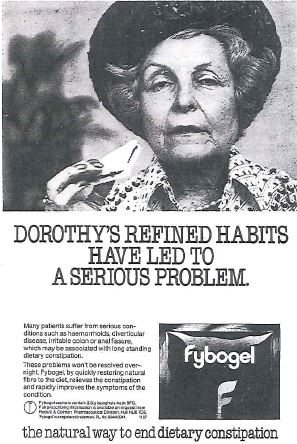
We shall now look at health, diet and social class. Firstly there is the obvious health hazard of being overweight (obese). Obesity is associated with an increased chance of suffering from heart disease, high blood pressure, diabetes and arthritis. And those of us who are overweight are likely to die younger. The more overweight, the greater the risk. (This is well known to life insurance companies, who adjust their premiums according to the weight of the person being insured.)
Obesity is believed to have increased in Britain since the 1940s among both adults and children. There has been a dramatic change since the early years of the century, when the poor suffered from undernutrition and obesity was a problem only for the rich. Now obesity is more of a problem for working class people — two out of every five working class women are seriously at risk because they are overweight.
Why has there been an increase in obesity? It is partly due to the increase in consumption of foods which are high in fats and sugar and low in fibre. Fats and sugar both contain more calories for their weight/than other foods we eat. Lack of fibre encourages obesity because without fibre the food is less bulky, you feel less full when you eat it, so you eat more and end up taking in more calories.
There are class differences not only in particular diseases such as obesity, but also in the overall health of the population. This can be seen in two ways: the death rates of babies, and the length of our lives. Again, there are good reasons to believe that these class differences are related to diet.
The likelihood of dying in childhood has diminished, but there is a disturbingly large class difference in a baby’s chances of surviving to its first birthday. In Scotland the differences are particularly marked: in 1972, of those babies born to unskilled workers, proportionally three times as many died as those born to professional and managerial families.
What is the reason for this class difference? Dr Taylor, who conducted extensive surveys of the problem, commented:
The key factors in infant mortality are maternal and infant nutrition (including the mother’s nutrition during her own childhood), child hygiene and skilled medical and nursing care during the antenatal, obstetric and postnatal periods.
Most important of these are maternal and infant nutrition, and here the real disposable family income….is >what matters,

Your class also affects how long you live, if you are an unskilled worker, you are not only twice as likely to suffer from chronic illness, but also your life is likely to be shorter than that of a professional or a manager.
What is more disturbing is that the gap between these classes is widening rather than narrowing. After rationing ended in the 1950s the gap in life expectancy between the classes widened by 25% in ten years and has continued to widen since.

Many researchers have concluded from extensive detailed studies that diet is the major factor contributing to life expectancy. During the war, for example, despite the civilian casualties, the deteriorating housing conditions and the overstretched medical facilities, civilian death rates actually decreased from 1940 to the end of the war. It seems that the reasons for this drop were food rationing (which ensured a more equal distribution of food between the classes) and changes in diet.
A recent study has shown it is diet which is also principally responsible for class differences in life expectancy. Dietary comparisons over the period (1964-74) showed dramatic class differences: the less well off ate 55% less fruit, 20% less fresh green vegetables, 30% less cheese, 20% less milk and 30% less carcass meat than the better off — but 32% more sugar.
WHY DO WE EAT WHAT WE DO?
In the late 18th and early 19th century, the mechanisation and rationalisation of agriculture meant that many thousands of people were no longer able to grow their own food. This trend was accelerated by the development of industrialisation and urbanisation. Thus the inhabitants of 19th century towns became entirely dependent for their food supplies on producers, wholesalers and retailers who were ultimately concerned with profit rather than nutritional value. This transformation of all food into a commodity has had far-reaching effects on our diet and our health.
During the early part of the last century food was in very short supply for most of the population, and what there was contained very little nourishment. This poor diet was reflected in high rates of sickness and premature death in the working class. Women in particular suffered as most of the food went to men in deference to their role as ‘breadwinner’.
A gradual improvement in diet for the mass of the population came about in the late 19th century as working class wages rose and food became more widely available. Overseas expansion opened up new areas of the world — at the expense of the local people — and the development of the steamship, the railway and various methods of food preservation (such as canning and refrigeration) made it possible to sell food on a large scale.
These changes did help to overcome deficiencies in the national diet. Combined with the introduction’ of public health measures, they contributed to the improvements in health and the dramatic fall in mortality rates that occurred in the latter part of the last century and the early part of this one.
But these changes were not all for the good. They included — and still include — preserving foods in high levels of various salts and, since the advent of cheap sugar, preserving in heavy syrups. The cold storage of fruit and vegetables has allowed us to eat the same crop throughout much of the year, but at a great loss of vitamins. The development of the high-speed steel roller mill, which separates the husk and germ from the wheat grain, enabled manufacturers to produce white flour more profitably than wholemeal.
Thus the types of food that have come to dominate our diet are those that the industry has found suitable for mass production and distribution, with a high profit element. Despite the enormous benefits that industrialisation has brought, the way that this industrialisation has developed — through the profit motive — has produced with the benefits a variety of hazards. Profit comes first, health is incidental.
Sugar and wheat are promoted by the food industry because of their cheap cultivation and ease in handling and shipping. White flour is more profitable than brown, because the bran and germ can be sold separately, and because white flour products are less satisfying to the appetite, so people tend to eat more of them. Sugar can make products more satisfying to the taste, particularly if we were encouraged as children to enjoy highly sugared products. As we have seen, sugar and white flour are among the foods causing ill-health. Animal fats have been associated with cancer of the bowel and the breast, and with heart disease. Yet some of the most profitable products of the meat industry, such as sausages and pies, are particularly high in fats.
The food industry has a particular problem. It cannot expect us to consume more of their products when our income rises. There is, after all, a limit to the amount we can eat, so that with a rise in real wages we do not buy more and more of the same sort of food. So in order to keep up their profits, the industry encourages us to shift our purchasing from food with less profit to food with more profit.
For example, during the ‘boom’ years of the 1960s the amount of spending on food, in real terms, increased very slowly — less than two percent over the decade. It may not sound as if profits would rise very rapidly during a period like that. Yet they did, because unprofitable foods were bought less and profitable ones more: sales of convenience foods were growing at ten times the overall rate, and frozen foods were increasing by 10% every year. By the end of the 1960s processed foods took about 60% of the household food budget.

Canned potato crisps at over £1.50 per lb.
Turning to the other means by which companies maintain their profits, we have the tendency .towards monopolisation. The health implications are simple: the quality and quantity of different foods, and the prices they are sold at, are less and less responsive to what consumers may want or need. Control over the nature of the food rests with a decreasing number of marketing executives. We live in an age when a lot of small companies are giving way to a few giants. During the 1960s the total assets owned by the bigger companies doubled, while the number of such companies halved. By the end of that decade, five firms or less controlled 90% or more of each of the following: sugar, breakfast cereals, soups, coffee, ice-cream, quick-frozen fish, frozen vegetables, self-raising flour and condensed milk. In some cases one company alone has come to dominate over half the sales:
Company Percent sales
- Unilever: Margarine 70%
- Unilever: Fish 63%
- Heinz: Canned soup 63%
- Tate & Lyle: Sugar 60%
- Kellogs: Breakfast cereal 56%
Even where no single company dominates there is little competition between firms. In the case of bread, for example, three companies supply 80% of the flour and two of them make well over half the bread we eat. They agree a high price for the flour so that other bakers cannot compete. Companies join together in powerful interest groups to help maintain their profitability and co-ordinate their labour force, as well as acting as a political pressure group. Recent examples of their tactics have been the concerted campaign by the Fruit and Vegetable Growers’ Association against the lorry drivers’ strike, and the campaign conducted by the Bakers’ Federation against striking bakery workers. The range and number of these manufacturers’ associations is very large, from the British Bacon Bureau and the British Sausage Bureau to the Ice Cream Alliance and the National Association of Soft Drink Manufacturers.
Sweets ‘are good for you’

THE MYTH OF CONSUMER SOVEREIGNTY
Wandering around a supermarket, we may happily believe that we are free to buy whatever food we want, and we can choose to be healthy or unhealthy as we please. This is just what companies want us to think. “The consumer rules in the market place — the consumer is sovereign.”
Is this really so? Let us look more closely at whether the the consumer really has a free choice. What does free choice assume?
Firstly it assumes that what we want is easily available:
- That it is within easy shopping distance so that time and effort are no problem
- That it is not expensive so that we can actually afford it
- That the quantity is appropriate and the quality acceptable
Secondly it assumes that we know what we want:
- That our choice is based on adequate information
Lastly it assumes that we have no problems preparing and consuming the food in the ways that we want:
- That we have the time to prepare it
- That we have the equipment and facilities
- Alternatively, that we can eat out or buy nutritious take-away food if we wish.
For most of us, all this is far from the truth. For example, the time and effort required for shopping are often a problem, particularly if transport is inadequate. Small neighbourhood shops are rarely able to buy the bulk qualities for which manufacturers give discounts. The quantities in which foods are packaged are increasingly geared to family consumption and those who can afford a cash outlay, private transport and a freezer. Single people — especially the elderly — suffer; for example, it is now impossible to buy a quarter pound of butter and difficult to buy half a pint of milk. And inevitably, the smaller the amount, the more it costs per mouthful
Then, of course, choice of food is strongly influenced by cost. White bread is cheaper than wholemeal — a fact determined by the milling industry — and more people buy it. It is claimed by the manufacturers that most people ‘prefer’ white bread to wholemeal, and so that is what they make. But when food rationing stopped after the last war the higher bran National loaf was cheaper than white bread and many more people bought it.
Another assumption about free choice is that we know exactly what is in what we are buying. The traditional way of judging food is through experience of its appearance and its taste. In relatively unprocessed foods, appearance is usually a good guide to nutritional quality and taste. But processed food now takes more than half our food budget.
One of the most dramatic effects of this processing has been to separate appearance and taste from nutritional value. The nourishment can be removed, and colouring and flavouring, including sugar, added so that the object looks as good as or better than the real thing, and the taste can be made palatable. And, of course, many foods are put in packages so that they cannot be judged at all, except by the picture on the wrapper. The result is that our judgment of food — our so-called free choice — is more and more under the control of the food manufacturers.
What information do we get from manufacturers? The law now requires that the ingredients should be put on the package,
Choices: slight differences in price, no difference-in content (try finding baked beans without sugar in them}. .

listed in the order of quantities by weight. This can tell, you, for example, whether a meat pie is made mainly of meat or of soya beans (textured vegetable protein). It can also help you keep an eye open for ingredients you may want to avoid. But it may be difficult to understand what the ingredients are from the way they are described on the label, so just having a simple list may not help. It says nothing about the calories (unless it claims to be a ‘slimming’ food), the safety of the additives or the nutritional losses made in processing the raw ingredients.
So where can we get more useful information? We might expect it to be easily obtained from government sources, such as the Ministry of Agriculture, Fisheries and Food which regulates food safety. But the committees of this department include representatives from the food industry and their concern is to protect their trade rather than help the consumer.
It is sometimes argued that the benefit of advertising is the factual information it gives on what products can be found where. How would you know that new potatoes were available if the greengrocer did not display a notice to say so? But most of the money spent on advertising is not spent on useful facts but on promoting competing food products. Particular lines, the most profitable ones, are advertised more than others. Indeed, if we ate foods in proportion to the amount spent on advertising them, our diet would be largely made up of confectionery, biscuits, breakfast cereals, margarine and potato crisps.
Commercial interests even enter health education. Nutrition education in schools and in the health service is dominated by films, books and leaflets sponsored by food companies. For example, the booklets most often given to expectant mothers in clinics and hospitals are financed by advertisements for baby foods or paid for by one of the companies, and a popular teaching kit for schools is produced by the British Sugar Bureau.
So the power of individual consumers to control and choose their food is reduced by the way manufacturers process the food. And yet the government and the food industry repeat: “We only supply what you ask for.”
This does not mean we are proposing that processed foods should be abolished. But we do believe that processing should be used to create better health, not larger profits.
MORE THAN YOU BARGAINED FOR – FOOD ADDITIVES
As we have indicated, the food companies produce, process and distribute food for its profit, not for its nutritive value. In order to maintain and expand their profits they frequently introduce additives which may be harmful. These are chemicals that would not normally be found in the food but are added as a preservative, to replace some of the nutritive value, to change the cooking properties, or to alter the texture, flavour or colour.
Four ounces of red tomato flavouring agent No.562 will “…standardise the flavour profile of tomato-containing products—and replace 100 lbs of tomato solids.” It is cheaper to make cakes appear buttery and full of eggs by adding small amounts of artificial substitutes than by using real butter and eggs. Poultry is often injected with polyphosphates to make it absorb substantial amounts of water. After all, why sell meat if you can sell water?

Of course, no company wants to poison its customers, and it will take pains to ensure that nobody drops dead holding one of its products. But the dietary causes of slow, chronic illnesses are very hard to detect, and companies do only the minimum research necessary. Even where there is evidence that additives may be harmful, they are still sometimes permitted. The colouring amaranth has been banned in the USA because of its association with cancer, miscarriages and birth defects, but it is still permitted in the UK.
Sensitivities to food additives vary greatly, children being especially vulnerable. The colouring agent tartrazine used in orange squash and orangeade has been shown to provoke asthma. Some people are adversely affected by the antibiotics fed to animals, and even by the detergent used to wash the carcasses.
Companies do not choose the safest processes or additives. They choose the cheapest. One of the more widely used additives is sodium nitrite, which is put into nearly all bacon, ham, sausages, processed meat, fish and cheese. Sodium nitrite forms potent cancer-causing agents (nitrosamines). It is used to prevent botulism and other microbial infections, but it is not necessary for this purpose. The meat could be processed, distributed and stored entirely under refrigeration, which would be more expensive, but might be a price we wished to pay. Another — safer — alternative would be ascorbic acid, but the companies prefer sodium nitrite because it stops the meat turning grey with age, making it look pink and fresh to the day it is eaten.
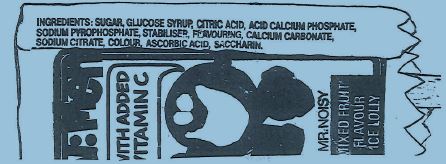
If it were sold as a food, the breast milk of many American mothers would be banned because the level of additives from the mother’s diet exceeds the permitted amounts. And the average corpse in the USA contains such highly concentrated additives that it too would be banned. A recent report from the US undertaking industry revealed that today’s corpses keep much longer than they used to because of the preservatives in our diet.
In the UK, as in many western countries, there is a close relationship between the food processing firms and the government regulatory agencies. This relationship is mediated by the scientific community, and the food companies can recruit the best scientists that money can buy. In public the companies hide behind government regulations, while in private they exert considerable influence in forming these regulations. The British government prefers to work through confidential consultations rather than public debate, and the technical data behind the policy decisions are all official secrets.
Standards of safety and toxicity are extremely hard to establish, for a number of reasons. First, there can be no such thing as a safe dose for chemicals that cause cancer or genetic mutation. Second, tests used to establish safety are usually performed on animals. There are no reliable ways of extrapolating to humans — what might be all right for a rat might not be for a child. The companies turn this argument around, of course, and say that a substance that affects rats will not necessarily affect us. Third, additives in different foods may affect each other in ways that are never tested.

Standards for foods are different from those used for additives. Sugar is accepted as a food, and is available for sale and consumed in massive amounts, to the detriment of our health. If it were now presented as an additive it would be banned and considered more dangerous than the artificial sweetener, cyclamate, Cyclamates were banned— but the research which led to this was paid for by the UK sugar industry.
The search for profit is perverting what we eat — introducing undesirable chemicals and undermining our health. The problems of additives are not simply technical — they are economic, social and political problems, and that is how we have to confront them.
SHOULDN’T THE GOVERNMENT DO SOMETHING?
The government has come to play an increasing role in influencing the chain of food production and consumption. After all, it was the government’s armed forces that enabled the expansion of the British Empire – allowing companies to exploit vast areas of the world and send back enormous wealth to Britain. And it was the government’s judicial forces that hanged three field labourers of Kent for demanding half-a-crown a day in wages, in the winter of 1830.
In 1901 the government discovered that there were not enough physically fit recruits to fight in the Boer War. It appeared to be inadequate nutrition in childhood that was producing weak and enfeebled adults. Britain s future was seriously threatened unless the health of the soldiers and workers could be improved to enable them to serve more effectively in economic expansion and in maintaining military strength. The government was obliged to intervene with measures including the introduction of free school meals and an early form of national insurance scheme. By providing for needy children and for workers and their families during sickness or unemployment, it was hoped that the physical fitness of the working class could be improved.
Nor is this approach entirely a thing of the past. In US Senate Committee Hearings in 1976, Senator Hubert Humphrey gave as a reason for wanting to improve the US national diet “…eliminating malnutrition among 3.3million poor children alone would produce a $6.3 to $18.8 billion increase in Gross National Product over the lifetimes of these children’
As far as influencing food production goes, the UK government must “now conform to EEC regulations. This means adopting a set of minimum prices that farmers are paid for their milk, sugar, beef, wine, oil and other products. The farmers can exert a lot of pressure on governments because of agriculture’s strategic role in the economy and because of the large number of rural votes, particularly in France and Germany — so the prices given to farmers are high. This encourages all farmers to produce as much of these products as they can, and we have as a result vast lakes of wine, oil and milk, and great mountains of butter, sugar and beef — and some well-off farmers.
Governments can also subsidise consumer prices, to encourage us to eat up the lakes and mountains. But food producers of other commodities, as well as tax payers generally, object to these uses of government money. Unilever, for example, which controls 70% of margarine sales, gets upset when the government subsidises butter. So such subsidies come and go with the political tide — and the relative strengths of the interest groups.
The government’s responsibility towards the consumer took a new turn recently. Instead of taking direct measures to ensure adequate diets when malnutrition is likely — as they did by having vitamin D added to margarine and by giving children school milk — they have decided to let us look after ourselves. They produced a pamphlet Eating for Health which concluded that good nutrition is a matter of Individual choice and instructed us to look after ourselves by eating wisely. The entire expertise available to the DHSS resulted in ten bits of advice to the public, including the following profound suggestions:
To eat less salt might be beneficial
It would do no harm for most people to eat a little less protein
Alcohol is not a necessary food
Obesity can mean ill-health or premature death.
A practical way…[to prevent obesity] is not to become overweight…
The pamphlet also suggested ‘it would be wise to reduce the amount of fat, especially saturated fat, in the diet’ (saturated fat is animal fat, including butter); and recommended that “the use of sugar and confectionery should be limited.” The same day this pathetic pamphlet was published the EEC announced new incentives to encourage more sugar consumption, and the government were also considering butter subsidies for the elderly and those on low incomes, to reduce the butter mountain.
If we still feel that we have a free choice in the sort of food we eat, then the companies, in their groups and alliances, and the government, shrugging off responsibility for general health, will all be delighted. When we fall ill they can deny responsibility. “It’s your choice — we told you to look after yourself” they will sing in chorus.
Well, look after ourselves we must. Not, of course, as the government proposes — as harassed individual shoppers. Responsibility for what food is produced and consumed is part of the political debate, involving food production workers and all of us as eaters
THE PRODUCTION PROCESS
The strength of companies ties in their ability to exploit the workforce, both at home and abroad. This exploitation has health consequences in the food industry as in many others. The food industry causes ill-health, not only because of what is produced, but also because of the way it is produced.
FOOD IMPERIALISM AND THE THIRD WORLD PRODUCERS
About a quarter of the world’s population live on the edge of starvation. Yet there is more than enough food in the world to feed everyone adequately. Starvation is not a result of overpopulation or of bad harvests, but results from the fact that the supply of food is in the hands of the rich.
In this section we show how the food industry contributes to the ill-health of third world producers through its role in the economic underdevelopment of the third world countries. In particular we see the direct health hazards resulting from growing crops for export at the expense of food for home consumption; we see the deplorable conditions of much of the third world workforce; and we see the food industry’s promotion of unhealthy products in the third world.
The main cause of ill-health throughout the underdeveloped, non-socialist world is poverty. At least a quarter of all children die before their fifth birthday, from a combination of malnutrition and infectious diseases which flourish in poor living conditions. Adults also suffer from a high rate of infectious diseases and nutritional deficiencies. The solution to these health problems lies in raising living standards — improving diet, housing, water supplies and sanitation.
Profit-seeking companies play a major role in perpetuating poverty — and disease — in the third world. They do this by controlling the third world’s resources and by making the third world countries dependent on western banks and the larger corporations. Unilever, for example, was founded upon the exploitation of third world vegetable oil resources and labour during the colonial period. Its continuing control over plantations and trading operations has served to ensure a cheap and secure supply of essential raw materials for its manufacturing industries.
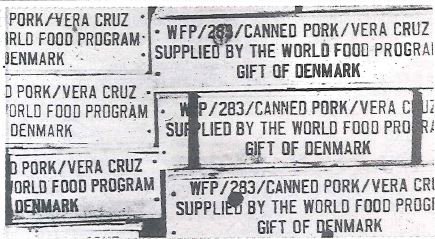
Pacific coast Latin Americans are frequently hungry, and may suffer from protein deficiency. Their fishermen catch anchovies, but Latin Americans do not eat this high protein diet, because they cannot afford the price. Instead, they put them in ships and send them to Denmark. The Danes don’t eat them but feed them to pigs — and then send cans of pork as food aid to Latin America.
CASH-CROPPING
The most significant form of exploitation is ‘cash cropping’ — growing food for export rather than for those who work the land. In the Philippines, for example, 55% of farm land is used for export crops. In Senegal over 50% of the land is given over to growing peanuts, most of which are exported for Unilever. During the recent famine in the area, exports of peanuts actually increased.
Underdeveloped countries export about 3.5 million tons of high quality protein a year to the industrialised west – roughly the nutritional needs of 300 million people. Yet much of the protein goes to feeding livestock or even pets.
The cash-crop system originated in the colonial days when land was seized and turned over to producing crops for export. Now the system continues with foreign companies working in partnership with local interest groups. In virtually all ex-colonial territories, the production of export crops continues to increase at the expense of domestic food crops. Many of these countries are now net importers of basic foods.
Unfavourable rates of exchange on the world market mean that these countries must continue to serve the interests of the multinational companies – the British companies that monopolise the tea trade, for example, control the entire foreign exchange resources of Sri Lanka — and this cannot help but exacerbate the problems of poverty and malnutrition.
WORKING CONDITIONS
The profits to be made in the underdeveloped countries are exacted at the price of desperate working conditions on the estates that the companies control. The suffering of tea workers in Sri Lanka, and West Indian banana plantation workers have been documented in recent years. A survey in South Africa in 1973 found that some companies (including Unilever, Rowntree Mackintosh and Tate and Lyle) were paying wages below the poverty datum line — i.e. starvation wages.
In addition to the malnourishment resulting from starvation wages, the insanitary living and working conditions for plantation workers make them highly susceptible to infectious diseases. Hookworm, for example, was referred to by colonial administrators as “the plantation disease” because of its common association with the terrible sanitary conditions on plantations — conditions which still prevail despite political independence.
SELLING MALNUTRITION
New health problems have emerged in the third world as the food companies, using aggressive sales techniques, have increasingly foisted their inappropriate processed foods on poor and malnourished populations.
The most notorious example is the marketing of artificial milk for babies. Bottle-feeding is far from ideal in the best of circumstances: in the third world the effects are frequently lethal. To feed a three-month-old baby on powdered formula can take up to third of a family’s income in the West Indies; as a result, the ‘milk’ gets watered down. With the added hazards of inadequate facilities for sterilisation, babies develop a combination of malnutrition and gastroenteritis — known throughout Africa and the Caribbean as the “lactogen syndrome.” Companies have used intensive advertising to persuade mothers that bottle feeding produces the healthiest babies, and even run ‘clinics’ with company representatives dressed as nurses.
The advertising of ‘tonics’ and ‘health foods’ such as Marmite in these countries can .also persuade people to . spend money that would be better used buying locally produced staples.

As the countries of the third world have thrown off colonialism, so they are now throwing off western -dominated capitalism. The success of their struggles for liberation poses a serious threat to the stability of capitalism, just as the Organisation of Petroleum Exporting Countries (OPEC) has given nearly a decade of capitalist recession in the oil-consuming west. Capitalism copes with the ‘energy’ crisis by letting inflation cut our real wages, by cutting public services and by putting many of us on the dole. And it will do the same in a ‘food’ crisis if we let it. Yet a fair price for imports can be paid by us, without the price being high, as long as we pay no extra for profit.
FARMWORKERS
To town dwellers, farming might seem a healthy occupation. But farmworkers must face the hazards of moving machinery, poisonous chemicals, chest diseases from grain dusts and infections from animals and plants.
Cases of occupational illness often fail to be identified because there are too few workers in one place for the connection to become clear. The many chemicals used in modern farming have effects on health which are as yet little understood. The long term effects of slight poisoning are often subtle, sometimes only coming to notice after many years of exposure. Other cases produce more immediate reactions. In 1967 five workers on a Derbyshire farm complained of impotence (nicknamed Derby Droop) which disappeared after they were taken off a crop-spraying job. In 1977 male workers at a California pesticide factory found that none of their wives were having children. One of the shop stewards found that he was sterile and persuaded the others to have tests. Over half the men who had worked with a particular chemical (DBCP) were sterile or had a very low sperm count. Other hazardous chemicals used in farming include the dinitro compounds such as DNOC, which causes sleeplessness and loss of weight with prolonged exposure; the organo-phosphorous insecticides which act as a nerve poison; and organic mercurial seed dressings which have subtle long-term effects on behaviour.
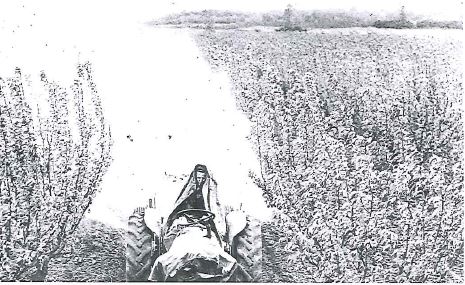
Agricultural chemicals are a potential danger not only to those who manufacture and use them, but also to the general public. The large quantities of nitrate fertilisers used on the land, for example, gradually find their way into our drinking water; the presence of high levels of nitrates in the water supply has been linked with stomach cancer. Whatever the benefits of such chemicals for raising productivity, workers and consumers have a common interest in demanding greater control over these substances and how, when — or if — they should be used in food production.
FOOD PROCESSING WORKERS
Those who work in food processing factories may not be much better off than the farmworkers. The baking industry has some of the worst conditions, exposing its workers to intense heat, excessively noisy and dangerous chopping and rolling machines, and high levels of dust.
Attempts by management at Manor Bakeries (Mr Kipling Cakes) to speed up production led to a walk-out by the mostly female workforce. Since the dispute began, the workers became more active in their union, and found that men under 20 and women under 19 were paid a special ‘junior’ rate despite doing the same work as others.
Work was divided into six grades, with men more commonly in the top ones. The lowest basic wage was £20 per week, about one third of the national industrial average.
There are aspects of food handling and packing which can also be hazardous, such as the dust from cardboard and paper, the dyes, plastics, resins and waxes on boxes, the noise in bottling plants and the fumes from cutting and sealing film wrapping.
CATERING WORKERS
Over two million people are employed in hotel and catering services in Britain. This includes everything from pubs, clubs and restaurants to catering in industry, local authorities, schools, colleges and the health services. Despite the fact that this sector employs more workers than any manufacturing industry except mechanical engineering, trade union organisation among catering workers is still extremely weak. In 1978 the average wage was calculated to be £34.12 for a 40 hour week. Such appalling wages, and the poor conditions which go with them, have been perpetuated through the exploitation of the most vulnerable groups of workers, notably women and immigrants (and often immigrant women).
Many catering skills are being eliminated as food preparation is increasingly centralised in industrial units where large numbers of meals can be prepared continuously for storage and future distribution:
‘…apricot pies were being prepared for blast-freezing in the Carter unit, and subsequent storage… too or three weeks’ stock is held in the cold store…of the 110 people who work in the catering unit only three are involved in full-time food production, 15 in serving in the main canteen, and the remainder are involved in reconstituting and serving-up, and distributing to the nine satellite kitchens and kiosks. ‘ (Catering contractors to the Central Electricity Generating Board)”
SELLING HYGIENE TO MANAGERS
Food preparation has become another assembly-line job. This de-skilling is carried to extremes by the American fast-food chains such as McDonalds; which are now expanding in Britain. Large quantities of food are rapidly assembled, packaged and served in throw-away containers by a chain of workers. On top of this boring and stressful work is another health risk to catering workers — their diet largely consists of the foods they have to serve up.
Labour is reduced to the minimum. “Labour out and machines in”says the catering advisor to GKN Sankey. Hence we have the introduction of vending machines for serving whole meals, using equipment such as microwave ovens to automatically reheat the food in seconds.
For the workers who find jobs in catering, the new technology brings new hazards. Microwave ovens, already a common feature of catering and now being introduced into domestic kitchens, are potentially dangerous to anyone who uses them. Despite stories of fingers and hands being cooked, the manufacturers assure us that the recent machines cannot be opened while the radiation is active. But leaks have occurred, and people working with the ovens have complained of burning sensations in their lungs, coughing and ‘sensitive’ eyes, Cataracts of the eye are a known hazard of prolonged exposure.
“I’m the king of the castle here. No-one comes in without my permission. If you come here like this again I’ll break your bloody leg.” So threatened Edward Ryde, managing director of Edward Ryde & Sons, pork pie manufacturers of Loscoe, Derbyshire, who was fined £100 for obstructing a factory inspector. The inspector suspected that Ryde was employing under-age children, which he was.
Ryde also told the inspector ‘I am entitled to break the law if I’m prepared to accept the consequences.” The firm was fined £150 for illegal employment of children.
Behind the low wages and the unpleasant working conditions of the food industry are the driving forces of standardisation, mechanisation and automation in the pursuit of profit. Any resulting benefits for food workers or consumers are incidental, as the long as the machines are worked and the food sold.
DOMESTIC PRODUCTION
In the last section we looked at the chain of production from the farm to the shop or canteen and the hazards, mechanisation and low pay that go with it. Many of the workers in these industries are women. The person who often finishes the chain
— buying, preparing and serving the food at home — is almost certain to be a woman. She does this very important work without pay and with insufficient credit from society at large. Her working conditions are not covered by protective legislation such as the Health and Safety at Work Act, and for many women the conditions are grossly inadequate. Twenty people die each day from accidents in the home and the kitchen is the single most dangerous area,
Probably my trouble is that I’m trying to be better at it than I need to be. Tom’s home so little that when he is home — even if it’s for a fortnight —I feel I’ve got to cook something interesting, and the effort that goes into that every night is a bit much really..
I find it so exhausting just trying to think of what to eat: that’s why I get so fed up with cooking. It’s not the actual cooking itself…
(Quoted by Ann Oakley, Housewife 1976)
When a woman serves up a meal she serves up herself.’ The food manufacturers are well aware of many women’s fears that the meal may be ruined or rejected by the family. What she needs is a meal which has her personal touch, but which is virtually guaranteed not to go wrong — and the industry is delighted to sell this to her. Few decisions are needed between the supermarket shelf and the dinner table. The effect of this, as we have seen earlier, is to place further control over our diet in the hands of the food companies.

WHERE NEXT?
According to the government, it is up to individuals to look after themselves and eat wisely because “their choice is their own responsibility.” Contrary to this, we have, argued that ill-health is socially rather than individually produced. Since the major force responsible for the social production of an unhealthy diet is the drive of the food industry to accumulate profits, personal choice in the matter is seriously limited.
In this pamphlet we have tried to show the importance of social and economic factors as causes of ill-health and in particular the way in which much illness in our society is produced by the kinds of food we now eat.
We already know enough about the changes in our diet which would be most likely to improve our health. The problem is how to fight for the necessary changes in food production: production for health, not for profit.
How do we start? A first step would be the active involvement of organisations and individuals in sharing information and formulating collective demands. This means bringing together people in the labour movement, the women’s movement, and workers in all aspects of food production and distribution. Equally, as food production and consumption are health issues, so health workers should be involved.
We can begin by working for straightforward reforms such as controls over misleading advertising. We can demand that more information on the content and nutritional value of processed foods be made widely available and that this should be quite independent of the promotional ‘information’ currently given. Such campaigns can help to restrain the more obvious abuses by the food industry, as the recent campaign against the baby milk manufacturers has shown. There is also a need for much stricter government regulations on additives and new food products. At the very least we can demand the kind of protection from hazards and access to information that other western countries increasingly provide.
But in the longer run it is not simply a question of demanding more state regulation, particularly when we realise that the government is not a neutral entity, but is in many ways actively promoting the very policies that we are challenging. We have no wish to increase state control over people’s lives. We are put in a position of demanding that the law be used because we have no way of influencing production directly.
it might be argued that any changes in production would put jobs at risk. In this way, workers in industry get caught up in the logic of capitalist production whether they want to or not, because within capitalism their wages and jobs depend on profit. This can make the prospect of radical change seem very threatening. Yet there is no reason why jobs should be at risk if demands for healthier food are taken up by the food workers themselves and are linked to decisions about what food should be produced, and how it should be produced. Campaigns for improved health must always go hand in hand with the struggle for socially useful, safe and rewarding jobs.
So first we can work to expose the hazards in food products, and the hazards of production itself. Secondly we can collectively set out a programme for their removal and replacement with health-giving food and healthy production methods. Such a programme will not be welcomed by the companies or the government; its success lies in our determination.
The authors of this pamphlet would very much like to participate in furthering debate and political activity around these important issues. We’ve raised some questions — it will take many other people to answer them.
…There was yet another bang on Monday night, but it took the police an hour and a half to trace the bombers’ target. It was the ‘urban guerrillas’ themselves who phoned to say that they had blown up seven of the biggest Roman salami manufacturers trucks: ‘This is “guerrilla communista”, we have just struck that starver of people…’ This justification was intriguing: The control of food chains’, say their leaflets, ‘has become one of the areas of worst exploitation and control by the bosses of the proletarian masses’. For the first time they are using bombs for consumer protection. The guilty salami, they claim, is made of meat rejects ‘and contains carcinogenous chemical additives which are fatal for the human organism’. New Statesman, 27.4.79
The Health Education Council’s current message, sponsored by the DHSS


